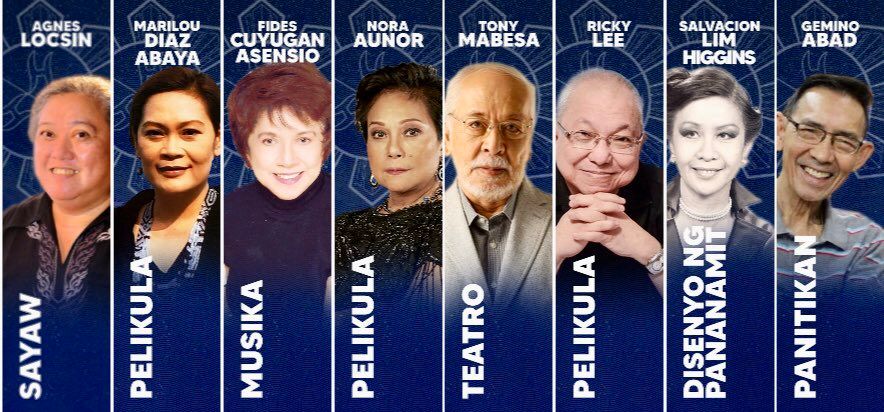Text by Henrylito D. Tacio
Photo: NCCA
A Dabawenya was among the 8 Filipinos who was named by the National Commission on Culture and the Arts to join the illustrious roster of Order of National Artists (ONA) last June 10.
Agnes D. Locsin is recognized for her significant contribution to the development of dance. Her dances “spurred a growing interest in neo-ethnic style among young artists,” said Proclamation 1390, which was signed by President Rodrigo R. Duterte.
Locsin is “considered one of the most progressive contemporary choreographers in the Philippines,” WikiPilipinas said.
“Her dances focus on Philippine beliefs and rituals, and ethnic and urban life,” the free Philippine Encyclopedia added.
Although her college degree is in English from Ateneo de Davao University, she earned her Masters of Arts in dance from Ohio State University in the United States.
Locsin learned dancing from her mother, Carmel Dakudao, who trained her under her tutelage at the Locsin Dance Workshop. Later on, she became a teacher and artistic director of the Locsin Dance Ensemble.
At the Ateneo de Davao, she was the dance director of Terpsichoreans. She also taught at the Cultural Center of the Philippines Dance School, the University of the Philippines College of Music, and the Jazz Tap Center.
Locsin also served as a dance consultant to the Philippine Educational Theater Association and Tanghalang Pilipino. Likewise, she was the artistic director of Ballet Philippines II.
The early dances she choreographed include Only a Woman, La Lupa, Dabaw, Igorot, Carmen, Teresa, and Ang Kapalit. In 1990, she choreographed Ismagol and Bagobo.
She choreographed three dances in 1991: Kulam, Moslem, and Moriones. In 1992, four dances were choreographed by her: Roll Over, Beethoven, Paglalakbay, Pas de Deux, and Encantada.
Locsin is the fifth woman to be recognized for her contributions to the development of Filipino dances.
Before her, there were Francisca Reyes-Aquino (1973 recipient), acknowledged as the folk dance pioneer; Leonor Orosa-Goquingco (1976), touted to be the “Mother of Philippine Theater Dance;” Lucrecia Reyes-Urtula (1988), who spent almost four decades in discovering and studying Philippine folk and ethnic dances; and Alice G. Reyes (2014), credited for the development of a distinctly Filipino modern dance idiom.
The only male to be recognized for his contribution in Filipino dances was Ramon A. Obusan (2006). He “broaden and deepened the Filipino’s understanding of his own cultural life and expressions.” He also “fortified cultural and diplomatic exchanges using the multifarious aspects and dimensions of the art of dance.”
Aside from Locsin, also declared National Artists of 2022 were film actress and singer Nora Aunor, scriptwriter Ricardo “Ricky” Lee, and the late award-winning director Marilou Diaz-Abaya. They were named for their contributions to Film and Broadcast Arts.
Although Antonio “Tony” Mabesa had also appeared in the movies and television, the NCCA cited him for his contributions to Philippine Theater.
The three remaining national artists for 2022 were Fides Cuyugan-Asensio for Music, Dr. Gemino H. Abad for Literature, and Salvacion Lim-Higgins for Design (Fashion).
All eight Filipinos, upon the joint recommendation of the NCCA and the Cultural Center of the Philippines, were officially announced as new national artists by virtue of Proclamation No. 1390.
The ONA, established under Proclamation No. 1001, signed in 1972 by then President Ferdinand E. Marcos, is the highest national recognition conferred upon Filipinos who have made distinct contributions to the development of the Philippine arts and culture.
The ONA “embodies the nation’s highest ideals in the humanities and aesthetics expression through the distinct achievements of individual citizens,” the NCCA said.
“These achievements are measured in terms of their vision, unusual insight, creativity and imagination, technical proficiency of the highest order in expressing Filipino culture and traditions, history, way of life and aspirations,” the NCCA explained.
National artists are entitled to a cash award of P200,000 net of taxes for living awardees and a one-time cash award of P150,000 net of taxes for posthumous awardees (payable to the legal heir/s). Those who are living after the conferment will receive a monthly life pension (P50,000), medical and hospitalization benefits (not exceeding P750,000 annually), and life insurance coverage for awardees who are still insurable.
In the event the national artist is insurable, the premiums for which shall be paid by the national government or by a donation from any governmental or private entities.
National artists will also have a place of honor, in line with protocolar precedence, at national state functions and recognition at cultural events.
Once the national artists die, they are entitled to a state funeral and burial at the Libingan ng mga Bayani.

